Military Personals Honored With Prestigious MacGregor Memorial Medal
Syllabus:Awards
- Five exceptional military personnel were conferred the prestigious MacGregor Memorial Medal for the years 2023 and 2024, recognising their outstanding contributions to military reconnaissance, adventure, and exploratory missions.
- The awards were presented by Chief of Defence Staff (CDS) General Anil Chauhan at a solemn ceremony hosted by the United Service Institution of India (USI) in New Delhi.

About the MacGregor Memorial Medal
- Established: July 3, 1888
- Named After: Major General Sir Charles Metcalfe MacGregor, founder of USI (established in 1870)
- Original Objective: To honour military officers who undertook significant exploratory and reconnaissance journeys.
- Expanded Scope (Post-1986): Includes military expeditions and adventure activities across terrains and environments.
- Eligibility: Open to all ranks (serving or retired) of the Armed Forces, Territorial Army, Reserve Forces, Rashtriya Rifles, and Assam Rifles.
- Total Medals Awarded: 127 (including 103 before Independence)
2023 Recipients
- Wing Commander D. Panda – Indian Air Force
- Electrical Artificer (Radio) Rahul Kumar Pandey – Indian Navy
2024 Recipients
- Chief Electrical Aircraft Artificer (Radio) Ram Ratan Jat – Indian Navy
- Sergeant Jhumar Ram Poonia – Indian Air Force
- Colonel Ranvir Singh Jamwal – Director, National Institute of Mountaineering and Adventure Sports (NIMAS), Arunachal Pradesh
- Note: Col. Jamwal is currently on an expedition to Kangchenjunga
Book Launch at the Ceremony
- Title: Bravest of the Brave
- Author: Gen. Satish Dua (Retd.)
- Subject: Chronicles the heroic life of Naib Subedar Chunni Lal, a Param Vir Chakra awardee, highlighting his valour and sacrifices.
With reference to the MacGregor Memorial Medal, consider the following statements:
- It was instituted by the Indian government post-Independence to recognise acts of gallantry in warfare.
- It is awarded to serving personnel only from the Indian Army.
- The medal also honours exploratory and adventure activities undertaken by military personnel.
- Colonel Ranvir Singh Jamwal, a 2024 recipient, is currently leading an expedition to Mt. Kangchenjunga.
Which of the statements given above are correct?
A) 1 and 2 only
B) 3 and 4 only
C) 2, 3 and 4 only
D) 1, 3 and 4 only
Answer: B) 3 and 4 only
Explanation:
- Statement 1 is incorrect – The medal was instituted in 1888 during British rule, not post-Independence.
- Statement 2 is incorrect – It is open to personnel from all branches: Army, Navy, Air Force, as well as Reserve and paramilitary forces.
- Statements 3 and 4 are correct – The scope was expanded post-1986 to include adventure/exploration; Col. Jamwal is currently on a Mt. Kangchenjunga expedition.
India’s Trade Dynamics in FY25 Surplus with US Widens, Deficit with China Deepens
Syllabus:Economy
- India’s trade performance in FY2024–25 reveals contrasting trends with its two major trading partners—the United States and China.
- While exports to the US surged, reinforcing India’s trade surplus with Washington, the trade deficit with China widened considerably, underscoring persistent import dependence.
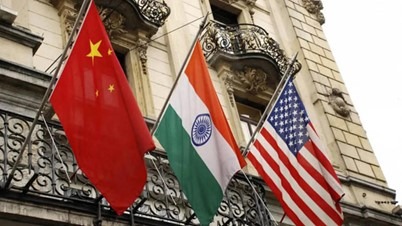
- Trade with the United States: Growing Surplus
- Exports to the US:Reached $86.5 billion, marking an 59% increase from $77.5 billion in FY2023–24.
- Imports from the US:Rose to $45.3 billion, a 44% rise from $42.19 billion the previous year.
- Trade Surplus:Expanded to $41.2 billion, up from $35.4 billion in FY2023–24, further cementing the US as India’s largest export market.
- Trade with China: Widening Deficit
- Exports to China:Declined sharply to $14.25 billion, registering a 49% fall from $16.66 billion in FY2023–24.
- Imports from China:Rose significantly to $113.45 billion, up 52% from $101.7 billion in the previous fiscal year.
- Trade Deficit:Ballooned to $99.2 billion, compared to $85.1 billion in FY2023–24.
- Major Import Drivers:Electronics, solar cells, electric vehicle (EV) batteries, and critical industrial components continue to dominate the import basket from China.
- Policy Implications and Trends
- The sharp rise in imports from China is partly attributed to the Production-Linked Incentive (PLI) schemes, which are driving domestic manufacturing and, paradoxically, increasing short-term demand for imported components.
- While the United States strengthens its position as India’s top export destination, the dependence on Chinese industrial inputs highlights
Consider the following statements regarding India’s bilateral trade with the United States and China in FY2024–25:
- India’s trade surplus with the United States increased primarily due to a fall in US exports to India.
- The widening trade deficit with China can partly be attributed to the import of intermediate goods linked to India’s PLI-driven manufacturing push.
- China retained its position as India’s top export destination and import source in FY2024–25.
- Despite higher trade with China, India’s export growth to the US outpaced its import growth from the US.
Which of the above statements is/are correct?
A) 2 and 4 only
B) 1 and 3 only
C) 1, 2 and 4 only
D) 2 only
Correct Answer: A) 2 and 4 only
Explanation:
- Statement 1 — Incorrect:The increase in India’s trade surplus with the US was driven by higher exports to the US (↑11.59%), not a fall in imports. In fact, imports from the US also increased (↑7.44%).
- Statement 2 — Correct:Imports from China rose due to rising demand for electronic components, EV batteries, and solar cells, much of which are intermediate goods required under Production Linked Incentive (PLI) schemes. This highlights India’s import-intensive manufacturing base, especially in emerging tech.
- Statement 3 — Incorrect:China remained India’s top import source, but not the top export destination. That title belongs to the United States, with exports worth $86.5 billion compared to $14.25 billion to China.
- Statement 4 — Correct:India’s exports to the US grew by 11.59%, outpacing the 44% growth in imports from the US. This led to a widening trade surplus with the US.
India’s Exports Rise Marginally by 0.7% in March 2025
Syllabus: Economy
- India’s foreign trade data for March 2025 and the full fiscal year 2024–25 indicates a delicate balancing act between marginal export growth and a sharp uptick in imports, resulting in a widening trade deficit and potential pressure on the current account position.
March 2025 Snapshot
- Merchandise Exports: $41.97 billion↳ Year-on-Year (YoY) growth: 7%, reflecting subdued global demand.
- Merchandise Imports: $63.51 billion↳ YoY growth: 3%, driven by rising consumption of energy products, electronics, and intermediate industrial goods.
- Trade Deficit: $21.54 billion↳ Marked deterioration from previous months due to a sharper import surge.

FY2024–25 Cumulative Trends (April 2024–March 2025)
- Total Goods Exports: $437.42 billion↳ Nominal YoY growth: 08%, signaling export stagnation despite global reopening.
- Total Goods Imports: $720.24 billion↳ YoY growth: 62%, reflecting resilient domestic demand and supply chain realignment.
- Overall Exports (Goods + Services): $820.93 billion↳ YoY growth: 5%, driven primarily by the services sector.
- Trade Deficit (Goods): Elevated due to strong import demand and weak manufacturing exports.
Drivers Behind the Trade Pattern
- Muted Global Demand: Particularly for labor-intensive and low-tech manufactured exports.
- High Base Effect: March 2024 exports were comparatively strong, muting YoY growth.
- Import Acceleration: Surge in crude oil, semiconductors, renewable energy components, and capital goods.
- Services Sector Resilience: IT, business process outsourcing, and financial services provided a buffer.
Macroeconomic Implications
- Current Account Pressure: Persistent trade deficits can widen the Current Account Deficit (CAD) and weaken external sector stability.
- Forex Implications: Rising import bills may lead to depletion of foreign exchange reserves if not offset by capital inflows.
- Policy Imperatives:
- Promote export diversification toward high-value and green technologies.
- Accelerate import substitution in electronics, energy components, and critical minerals.
- Strengthen logistics and trade facilitation to enhance cost competitiveness.
With reference to India’s trade performance in FY 2024–25, consider the following statements:
- India’s merchandise exports declined year-on-year compared to FY 2023–24.
- The services sector played a crucial role in sustaining overall export growth.
- The trade deficit in March 2025 narrowed due to reduced imports.
- Electronics and industrial inputs were key drivers of India’s import surge.
Which of the statements given above are correct?
A. 1 and 3 only
B. 2 and 4 only
C. 1, 2 and 4 only
D. 2, 3 and 4 only
Answer: B. 2 and 4 only
Statement 1 is incorrect (exports showed marginal growth of 0.08%).
Statement 3 is incorrect (trade deficit widened due to rising imports).
Explanation:
- According to official data, India’s merchandise exports in FY 2024–25 amounted to $437.42 billion, which reflects a marginal increase of 0.08% over the previous year.
- While this growth is minimal and signals stagnation, it is still a positive figure, not a decline.
- Despite slow growth in goods exports, India’s services exports remained strong, leading to a 5.5% rise in total exports (goods + services) in FY 2024–25.
- Sectors like IT, BPO, and financial services contributed significantly to maintaining export momentum.
- In March 2025, imports rose sharply by 11.3%, while exports increased only slightly (0.7%).
- This led to a widening of the trade deficit to $21.54 billion, up from earlier months.
- Therefore, the trade deficit did not narrow — it widened due to increased import demand.
Tamil Nadu Forms High-Level Committee To Strengthening State Autonomy
Syllabus:Polity
- In a significant assertion of federal principles, Tamil Nadu Chief Minister K. Stalin announced the formation of a three-member high-powered committee on April 15, 2025, tasked with a comprehensive review of Centre–State relations, constitutional allocations of power, and intergovernmental fiscal dynamics.
- The move underscores persistent concerns over centralisation and erosion of State autonomy in India’s federal architecture.
Committee Overview
- Constituted by: Tamil Nadu Government
- Chaired by: Justice Kurian Joseph (Retired Supreme Court Judge)
- Other Members:
- Ashok Vardhan Shetty, Retd. IAS & former Vice-Chancellor, Indian Maritime University
- Naganathan, Former Vice-Chairman, Tamil Nadu State Planning Commission
- Interim Report: Due by January 2026
- Final Recommendations: Within two years
Mandate and Scope
- The committee will:
- Scrutinize constitutional provisions, statutes, and policies governing Centre–State relations.
- Recommend the re-transfer of subjects from the Concurrent List to the State List.
- Suggest reforms to enhance administrative and fiscal autonomy of States while maintaining national integrity.
- Examine the Rajamannar Committee (1969), Sarkaria Commission (1983), and Punchhi Commission (2007) reports for precedent and relevance.
Historical Context
- Rajamannar Committee (1969), appointed by DMK founder M. Karunanidhi, had flagged excessive centralisation.
- In 1974, the Tamil Nadu Legislative Assembly formally adopted its recommendations—many of which remain unimplemented.
Key Federal Grievances Raised
- NEET Controversy
- Seen as infringing on State’s education policy autonomy.
- Allegedly disadvantages students from marginalized backgrounds in Tamil Nadu.
- State legislation exempting NEET was withheld Presidential assent, sparking constitutional friction.
- National Education Policy (NEP) 2020
- The three-language formula is perceived as Hindi imposition.
- Funds worth ₹2,500 crore under Samagra Shiksha Abhiyan reportedly withheld.
- Renewed demand to move Education back to the State List.
- Fiscal Centralisation via GST
- Tamil Nadu, a net contributor, receives only ₹0.29 for every rupee it contributes.
- The GST regime has allegedly eroded States’ revenue-raising powers.
- Tamil Nadu’s objections during GST Council deliberations were reportedly disregarded.
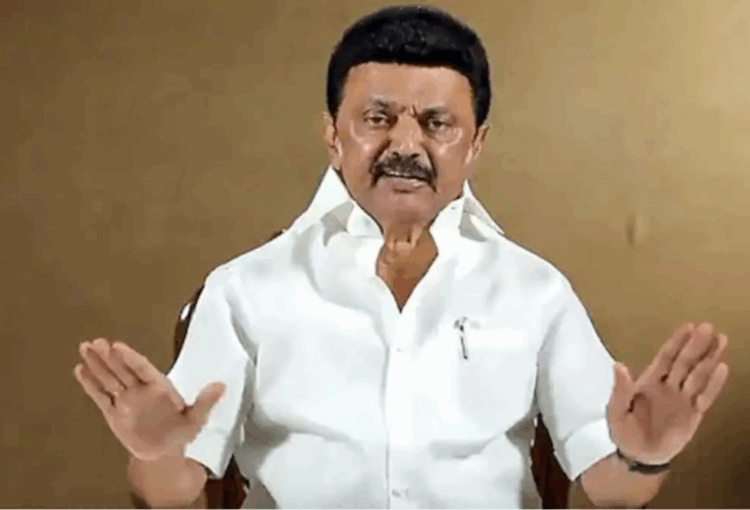
Delimitation 2026
- Based on population, it may reduce Tamil Nadu’s parliamentary seats.
- Seen as punishing states with successful population control policies, violating cooperative federalism norms.
- This institutional move marks a serious federal challenge to the existing Centre-State dynamic. It could serve as a reference point for other states concerned with over-centralisation and the rebalancing of India’s quasi-federal structure.
With reference to the Tamil Nadu High-Level Committee on Centre–State Relations (2025), consider the following statements:
- The committee includes members from both the judiciary and civil services.
- One of its mandates is to recommend restoration of subjects from the Union List to the State List.
- The move revives themes earlier discussed by the Rajamannar and Punchhi Commissions.
- The committee is mandated to submit its final report before the 2026 delimitation process begins.
Which of the above statements is/are correct?
A. 1 and 3 only
B. 1, 2 and 4 only
C. 1 and 2 only
D. 1, 3 and 4 only
Correct Answer: A. 1 and 3 only
Explanation:
- Statement 1: Correct – The committee is chaired by a retired Supreme Court judge and includes a retired IAS officer.
- Statement 2: Incorrect – The recommendation concerns Concurrent List to State List, not Union List.
- Statement 3: Correct – The mandate explicitly refers to past federal commissions, including Rajamannar and Punchhi.
- Statement 4: Incorrect – The committee will submit its interim report by Jan 2026, while final report is due within two years, i.e., after the 2026 delimitation exercise.
WHO Pandemic Treaty Proposal Finalised
Syllabus:Health
- The World Health Organization (WHO) has finalized a groundbreaking proposal for a Pandemic Treaty, a global agreement aimed at enhancing pandemic prevention, preparedness, and response.
- This proposal, developed by the Intergovernmental Negotiating Body (INB), will be presented at the 78th World Health Assembly (WHA) on May 19, 2025.
- The treaty emerges after extensive negotiations and is designed to foster international cooperation while respecting national sovereignty, ensuring a fair and swift response to future global health crises.
Key Highlights
Formation & Purpose:
- The proposal was finalized by the INB, which was created in December 2021.
- Its primary goal is to establish a binding international instrument under the WHO Constitution to improve pandemic prevention, preparedness, and response (PPR).
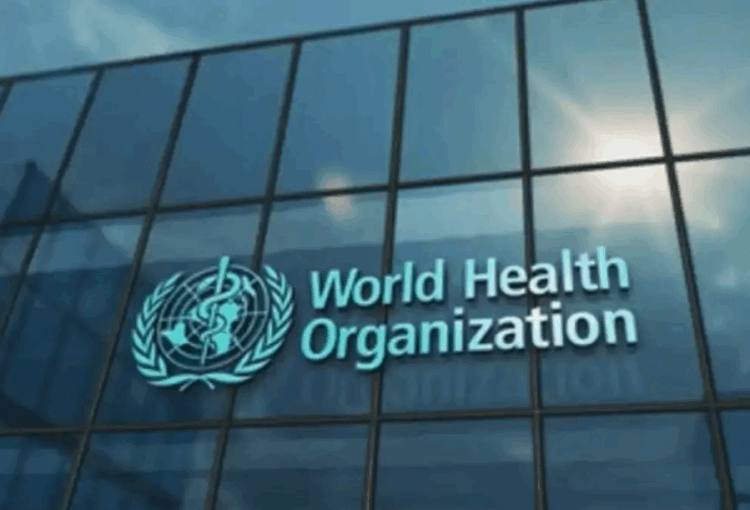
Timeline of Negotiations:
- The INB held 13 formal negotiation rounds, with 9 extended sessions, alongside several informal and intersessional discussions.
- The final text will be reviewed at the 78th WHA in May 2025.
Major Provisions in the Draft Text:
- Pathogen Access and Benefit-Sharing System (PABS): Establishes mechanisms for equitable sharing of pathogens and benefits.
- One Health Approach: A holistic strategy linking human, animal, and environmental health.
- Equitable R&D and Technology Transfer: Focuses on promoting diverse R&D capacities and ensuring technology, skills, and knowledge-sharing globally.
- Global Health Emergency Workforce: Creation of a skilled, multidisciplinary workforce for pandemic responses.
- Global Supply Chain: Establishment of a coordinated network for distributing health products.
- Financial Mechanism: A global fund to support pandemic preparedness and response.
Safeguarding National Sovereignty:
- The treaty respects national sovereignty in public health matters and does not grant WHO the authority to:
- Impose national laws or policies.
- Mandate travel bans, lockdowns, vaccinations, or therapeutics.
- Ensure voluntary compliance while respecting national jurisdiction.
Statements from WHO:
- Tedros Adhanom Ghebreyesus, WHO Director-General, described the agreement as a “generational accord” that demonstrates the continued relevance of multilateralism in addressing global health challenges.
Consider the following statements regarding the WHO Pandemic Treaty:
- The Intergovernmental Negotiating Body (INB), established in 2021, finalized the draft text for the Pandemic Treaty to be presented at the 78th World Health Assembly (WHA) in May 2025.
- The proposed treaty aims to establish a Pathogen Access and Benefit-Sharing System (PABS) to ensure equitable access to pandemic-related technologies, including vaccines.
- The One Health Approach, integral to the treaty, emphasizes only the health of humans, disregarding the interconnections between environmental and animal health.
- The treaty allows the World Health Organization (WHO) to impose mandatory travel bans, lockdowns, and vaccinations during future pandemics, overriding national sovereignty.
Which of the above statements are correct?
A. 1 and 2 only
B. 1, 2, and 3 only
C. 2 and 4 only
D. 1, 3, and 4 only
Answer: A. 1 and 2 only
Explanation:
- Statement 1 is correct: The INB, established in December 2021, has finalized the draft text of the Pandemic Treaty, which will be presented at the 78th World Health Assembly (WHA) in May 2025.
- Statement 2 is correct: The treaty proposes the creation of a Pathogen Access and Benefit-Sharing System (PABS), which aims to ensure equitable access to pandemic-related technologies, including vaccines and treatments.
- Statement 3 is incorrect: The One Health Approach is designed to recognize and address the interconnections between human, animal, and environmental health, contrary to what is suggested in the statement.
- Statement 4 is incorrect: The treaty does not grant the World Health Organization (WHO) the authority to impose mandatory travel bans, lockdowns, or vaccinations. Instead, it emphasizes voluntary implementation respecting national sovereignty, ensuring that these measures remain within the jurisdiction of individual nations.
Indian Navy Hosted 3rd Edition Of Meghayan-25
Syllabus:Defence
- The Indian Navy hosted the 3rd edition of its prestigious Meteorological and Oceanological Symposium – Meghayan-25 on April 14, 2025, at Nausena Bhawan, New Delhi.
- This event, which coincided with the World Meteorological Day 2025, aimed to foster awareness and collaboration in Marine Meteorology and Oceanology.
- The symposium featured participation from key scientific and defense institutions, and its theme highlighted efforts towards closing gaps in early warning systems.
Key Highlights
- Event Name: Meghayan-25
- Organized By: Indian Navy
- Edition: 3rd
- Date: April 14, 2025
- Venue: Nausena Bhawan, New Delhi
- Occasion: World Meteorological Organization (WMO) Day 2025
- WMO Day Theme: “Closing the Early Warning Gap Together”
Inauguration and Dignitaries
- Virtual Inauguration: Admiral Dinesh K Tripathi, Chief of the Naval Staff
- Presided Over By: Vice Admiral Krishna Swaminathan, Vice Chief of Naval Staff
Key Attendees:
- VAdm Tarun Sobti – Deputy Chief of Naval Staff
- VAdm Lochan Singh Pathania – Chief Hydrographer to Government of India
- Nilesh Desai – Director, SAC Ahmedabad (Guest of Honour)
- Mrutyunjay Mohapatra – DG, IMD & Hony Vice President, WMO (Keynote Address)
Participating Institutions:
- India Meteorological Department (IMD)
- Indian Institute for Tropical Meteorology (IITM)
- Indian National Center for Ocean Information Services (INCOIS)
- National Institute of Ocean Technology (NIOT)
- Space Applications Centre (SAC), ISRO
- Indian Air Force
- National Maritime Foundation (NMF)
- IIT Madras

Technical Sessions
- Session I:
- Moderator: RAdm G Rambabu (Principal, INA)
- Focus: Developments in Marine Meteorology and Oceanology
- Format: Presentations and Q&A
- Session II:
- Moderator: Cmde SMU Athar
- Focus: Statistical Approaches in Weather Forecasting
- Format: Presentations and Audience Interaction
Panel Discussion:
- Theme: “Closing the Early Warning Gap Together: Enhancing Maritime Security and Coordination”
- Moderator: VAdm Pradeep Chauhan (Retd), Director General, NMF
- Objective: Strategies for Integrated Maritime Safety and Disaster Preparedness
Key Highlights and Launches:
- Felicitation of Cmde PI Oommen (Retd): Honored as the pioneer of the Navy’s Meteorological Specialisation.
Launch of MOSDAC-IN Web Services:
- Jointly developed by DNOM and SAC
- Offers customized satellite-based weather data with individual logins for Naval Met Offices.
Revival of the Sagarmanthan Journal:
- The 10th edition was launched after a decade-long gap.
- This symposium aimed to enhance collaboration between defense and scientific bodies to improve maritime safety and weather forecasting, with a focus on bridging gaps in early warning systems and disaster preparedness.
Consider the following statements regarding the Meghayan-25 symposium organized by the Indian Navy:
- The symposium was held to mark World Meteorological Day 2025 and focused on closing gaps in early warning systems.
- The theme for World Meteorological Day 2025 was “Enhancing Maritime Security and Coordination.”
- The symposium featured participation from key defense and scientific institutions, including the India Meteorological Department (IMD) and ISRO’s Space Applications Centre (SAC).
- The event included technical sessions focusing on developments in marine meteorology, statistical approaches in weather forecasting, and integrated maritime safety.
Which of the above statements are correct?
A. 1, 3, and 4 only
B. 2, 3, and 4 only
C. 1, 2, and 3 only
D. 1, 3, and 4 only
Answer: A. 1, 3, and 4 only
Explanation:
- Statement 1 is correct: The Meghayan-25 symposium was indeed held to mark World Meteorological Day 2025, with a focus on closing gaps in early warning systems.
- Statement 2 is incorrect: The theme for World Meteorological Day 2025 was “Closing the Early Warning Gap Together,” not “Enhancing Maritime Security and Coordination.”
- Statement 3 is correct: The symposium involved participation from important defense and scientific institutions like IMD, SAC, and others.
- Statement 4 is correct: The event had technical sessions focusing on developments in marine meteorology, weather forecasting, and integrated maritime safety.
Ministry of Ayush Organized Rashtriya Karmayogi Jan Seva Programme
Syllabus:Health
- The Ministry of Ayush organized a special session of the Rashtriya Karmayogi Jan Seva Programme at Ayush Bhawan in New Delhi on April 16, 2025.
- This initiative is part of the Mission Karmayogi framework and was conducted in collaboration with the Capacity Building Commission (CBC).
- The programme focuses on improving service orientation, enhancing professional capacity, and boosting public service efficiency among the personnel of the Ministry.
Key Highlights
- Organizing Ministry: Ministry of Ayush
- Programme Name: Rashtriya Karmayogi Jan Seva Programme
- Date of Event: April 16, 2025
- Venue: Ayush Bhawan, New Delhi
- Under Mission: Mission Karmayogi
- Collaboration: Capacity Building Commission (CBC)
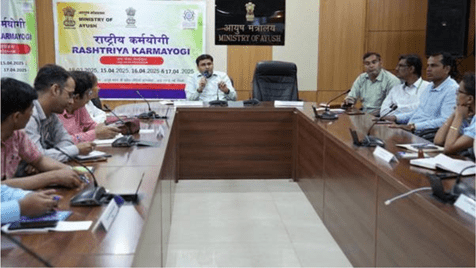
Phase-wise Programme Overview
- First Phase:
- Inaugurated by: Vaidya Rajesh Kotecha, Secretary, Ministry of Ayush
- Focus on cultivating a responsive and efficient workforce.
- Emphasis on the practical application of training in daily official duties.
- Second Phase:
- Led by: Dr. Subodh Kumar (Programme Director)
- Facilitated by: Ms. Shipra Singh
- Focused on interactive, activity-based learning.
- Included group discussions, team exercises, and problem-solving activities.
Core Themes of the Training Sessions
- Self-awareness
- Motivation
- Leadership
- Public Service Contribution
- The training utilized case studies from Ayurveda, Yoga, and traditional medicine as tools for learning, incorporating real-life examples to ensure contextual relevance for the participants.
Participation and Impact:
- Ministry officials actively participated, gaining a deeper understanding of their roles in public service.
- The programme strengthened their awareness of organizational goals and the importance of citizen-centric service delivery.
Consider the following statements regarding the Rashtriya Karmayogi Jan Seva Programme conducted in April 2025:
- The programme was held under the framework of Mission Karmayogi in partnership with the NITI Aayog.
- It was designed to enhance service delivery efficiency, leadership skills, and self-awareness among officials of the Ministry of Ayush.
- Real-life case studies from traditional Indian systems like Ayurveda and Yoga were integrated into the training modules.
- The programme was entirely lecture-based with minimal emphasis on group interaction or practical exercises.
Which of the statements given above are correct?
A. 1 and 2 only
B. 2 and 3 only
C. 1, 2 and 4 only
D. 2, 3 and 4 only
Answer: B. 2 and 3 only
Explanation:
- Statement 1 is incorrect: The programme was organized in collaboration with the Capacity Building Commission (CBC), not NITI Aayog.
- Statement 2 is correct: One of the key goals was to improve public service efficiency, motivation, leadership, and self-awareness among Ayush Ministry personnel.
- Statement 3 is correct: Training sessions incorporated case studies from Ayurveda, Yoga, and traditional systems to enhance contextual relevance.
- Statement 4 is incorrect: The programme emphasized interactive and activity-based learning, including team exercises and group discussions, rather than being purely lecture-based.
NITI AAYOG Launched Unlocking $25+ Billion Export Potential Report
With reference to the recent NITI Aayog report “Unlocking $25+ Billion Export Potential – India’s Hand & Power Tools Sector”, consider the following statements:
- The report projects that achieving the $25 billion export target in hand and power tools could generate over 3 crore jobs, primarily in services and IT sectors.
- India currently holds a greater global market share in power tools exports than in hand tools exports.
- China accounts for nearly half of the global exports in both hand and power tools, significantly dominating the sector.
- The report recommends that any cost disadvantage faced by Indian manufacturers should be offset through increased direct fiscal subsidies over the long term, regardless of policy reforms.
Which of the above statements is/are correct?
- 1 and 2 only
B. 3 only
C. 2 and 4 only
D. 1, 3, and 4 only
Answer: B. 3 only
Explanation:
- Statement 1 – Incorrect: While the report does project the creation of 35 lakh (3.5 million) jobs, these are primarily in the manufacturing and export sectors, not services or IT.
- Statement 2 – Incorrect: India’s global market share in hand tools (1.8%) is currently higher than that in power tools (0.7%).
- Statement 3 – Correct: China is indeed the dominant global exporter, accounting for ~50% of hand tools and ~40% of power tools exports—an accurate representation of the competitive landscape.
- Statement 4 – Incorrect: The report states that direct fiscal subsidies are not required if structural reforms are implemented. Bridge cost support (₹8,000 crore) is only a contingency plan if reforms are delayed, not a long-term recommendation.
Which of the following is the primary religious significance of Thangjing Hills in Manipur?
- It is considered the sacred abode of the Meitei deity Eputhou Thangjing.
- The hills are considered a symbol of unity between the Meitei and Kuki-Zo communities.
- The pilgrimage to Thangjing Hills is a part of the Kuki-Zo religious tradition.
- The site is linked to the Khamba-Thoibi legend, central to Meitei mythology.
Select the correct answer using the code below:
A) 1 and 4 only
B) 2 and 3 only
C) 1, 3, and 4 only
D) 1, 2, and 4 only
Answer: A) 1 and 4 only
Explanation:
- Thangjing Hills is regarded as the sacred abode of Eputhou Thangjing, a central Meitei deity.
- It is also linked to the Khamba-Thoibi myth, which is integral to Meitei folklore.
- The opposition from the Kuki-Zo community is rooted in ethnic tensions rather than religious unity, hence the other options are incorrect.
Justice BR Gavai Next CJI of India as Successor to Chief Justice Sanjiv Khanna
Syllabus:Polity
- On April 16, 2025, Chief Justice of India (CJI) Sanjiv Khanna formally recommended Justice Bhushan Ramkrishna Gavai, the senior-most puisne judge of the Supreme Court, as his successor.
- The recommendation was sent to the Union Ministry of Law and Justice in accordance with established constitutional convention.
- Upon receiving presidential assent, Justice Gavai will assume office as the 52nd Chief Justice of India following the retirement of CJI Khanna on May 13, 2025.
- Judicial Profile: Justice B.R. Gavai
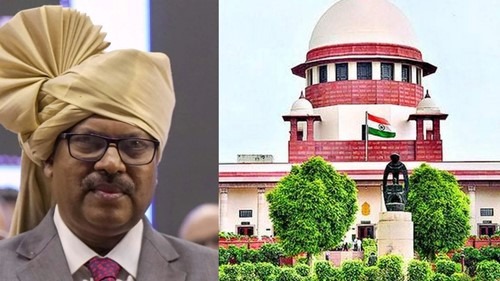
Early Life and Legal Career
- Birthplace: Amravati, Maharashtra.
- Commencement of Practice: Enrolled with the Bar in 1985.
- Worked under Raja S. Bhonsale, former Advocate General of Maharashtra and later a Bombay High Court judge.
- Practised primarily before the Nagpur Bench of the Bombay High Court, specialising in constitutional and administrative law.
Government Appointments
- Appointed as Assistant Government Pleader and Additional Public Prosecutor in 1992–93.
- Promoted to Government Pleader and Public Prosecutor in 2000.
- Judicial Appointments
- Appointed as an Additional Judge of the Bombay High Court in November 2003.
- Made Permanent Judge of the Bombay High Court in November 2005.
- Elevated to the Supreme Court of India in May 2019.
Key Judicial Contributions
- Demonetization Verdict (January 2023)
- Justice Gavai was part of the majority in a 4:1 Supreme Court verdict upholding the constitutionality of the Central Government’s 2016 decision to demonetize ₹500 and ₹1,000 notes. The judgment emphasized Parliament’s legislative competence and the Reserve Bank of India Act framework.
Sub-Categorization within SCs and STs (August 2024)
- In a significant case involving affirmative action, Justice Gavai supported the application of the “creamy layer” principle to Scheduled Castes and Scheduled Tribes. His opinion aimed to ensure targeted benefits for the most disadvantaged within these groups.
Abrogation of Article 370 (December 2019)
- As a member of the Constitution Bench, Justice Gavai upheld the Centre’s decision to abrogate Article 370, thereby revoking the special status granted to the erstwhile state of Jammu & Kashmir. The bench reaffirmed Parliament’s power under Article 356 and Article 370(3).
Critique of Bulldozer Demolitions (November 2024)
- Justice Gavai, in a two-judge bench, condemned the practice of extra-legal demolitions of properties linked to alleged criminals. He emphasized that due process of law must prevail, and state action must adhere to constitutional principles.
Significance of the Appointment
- Justice Gavai’s elevation is not only significant due to his legal acumen but also because he is set to become the second Dalit Chief Justice of India, following Justice K.G. Balakrishnan. His appointment reaffirms the inclusive and meritocratic foundations of India’s higher judiciary.
Consider the following statements regarding Justice B.R. Gavai and his contributions to Indian constitutional jurisprudence:
- Justice Gavai, in his verdict on the abrogation of Article 370, relied primarily on the doctrine of basic structure to uphold the revocation.
- He has been a strong proponent of sub-categorization within Scheduled Castes and Scheduled Tribes, arguing for the application of the creamy layer doctrine to improve intra-group equity.
- As part of the Demonetization verdict, Justice Gavai held that the government had exceeded its authority under Section 26(2) of the RBI Act, thereby dissenting from the majority.
- In 2024, Justice Gavai raised constitutional concerns over the use of bulldozers for punitive demolitions, highlighting violations of the principles of natural justice and rule of law.
Which of the statements given above is/are correct?
A. 2 and 4 only
B. 1, 3 and 4 only
C. 1 and 3 only
D. 2, 3 and 4 only
Answer: A. 2 and 4 only
Explanation:
- Statement 1 – Incorrect: Justice Gavai upheld the abrogation of Article 370 but did not rely on the basic structure doctrine to support the decision. Instead, the judgment was rooted in a textual and procedural interpretation of Article 370(3) and the constitutional provisions relating to Presidential powers during President’s Rule (Article 356).
- Statement 2 – Correct: In the August 2024 case, Justice Gavai supported sub-categorization within SC/STs and proposed the application of the creamy layer principle, a significant judicial position aimed at equitable distribution of affirmative action benefits.
- Statement 3 – Incorrect: Justice Gavai was part of the majority (not dissent) in the 2023 Demonetization verdict. He ruled that the government’s action under Section 26(2) of the RBI Act was constitutionally valid and within the framework of delegated legislation.
- Statement 4 – Correct: Justice Gavai indeed raised concerns in a 2024 judgment against bulldozer-driven demolitions that bypassed due legal process, terming such actions unconstitutional and in violation of Article 14 (equality before the law) and Article 21 (right to life and personal liberty).
